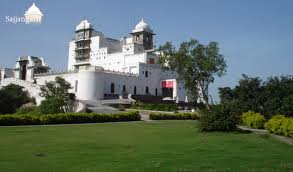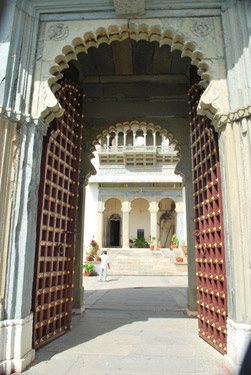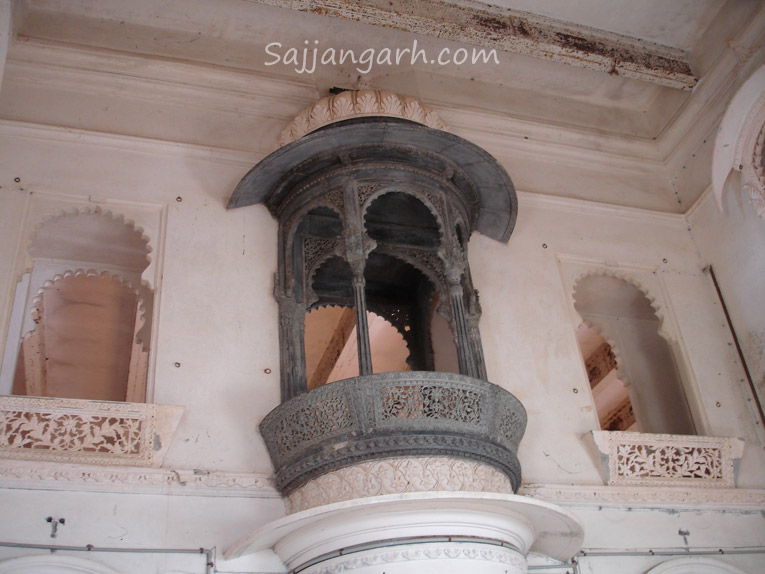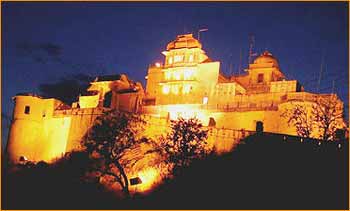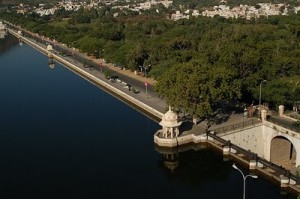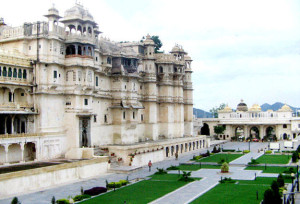India /Rajasthan /Udaipur /Udaipur
Sight Address : Sajjangarh Palace (Monsoon Palace)Bansdara,Mountainp, Udaipur, Rajasthan, India Edit
Detail InformationEdit
The Monsoon Palace, formerly known as the Sajjan Garh Palace, is a hilltop palatial residence in the city of Udaipur, Rajasthan in India, overlooking the lake Pichola. It is named as Sajjangarh after Maharana Sajjan Singh (1874–1884) of the Mewar Dynasty, who built it in 1884. It offers a panoramic view of the city’s lakes, palaces and surrounding countryside. It was built basically to watch the monsoon clouds; hence, appropriately, it is popularly known as Monsoon Palace. It is said that the Maharana built it at the top of the hill to get a view of his ancestral home of Chittaurgarh. Previously owned by the Mewar royal family, it is now under the control of the Forest Department of the Government of Rajasthan and has been opened to the public recently. The palace provides a beautiful view of the sunset.
HistoryEdit
The Monsoon Palace, formerly known as the Sajjan Garh Palace, is a hilltop palatial residence in the city of Udaipur, Rajasthan in India. The Monsoon Palace was built by Maha Rana Sajjan Singh and also named after him in the year 1884. The Maha Rana had planned to build nine storied observatory here for the purpose of observing the monsoon arrival and predicting the weather. However, it could not be met as he passed away at a young age. Towards the left of the Monsoon heritage palace is Shikarbadi, a shooting box located on the southern end of the Lake Pichola. It was built by Maha Rana Sajjan Singh and it is converted into a small palace now. It reflects the history of the Mewar kingdom. Sajjan Singh, Maharana (b. July 18, 1859 d. December 23, 1884), the initial builder of the Monsoon Palace was the seventy–second ruler of the Mewar Dynasty (1874–1884) and he ruled from Udaipur for a short period of 10 years until his untimely death. The Mewar dynasty traces its history to Guhil who founded the Mewar State in 568 AD.Even though Sajjan Singh accepted the crown when he was 15 years old, his uncle Sohan Singh had challenged his right to the crown and even plotted through astrologers, who had said the timing for the coronation was not appropriate. But the then British agent, who was in favour of Sajjan Singh, intervened and persuaded the astrologers to give a favourable date for the crowning. But the Coronation of Sajjan Singh took place two years after he was nominated to the crown. As the trouble maker uncle was still persisting with his obdurate attitude towards the newly crowned Maharana, his property was confiscated and he was also incarcerated. The Maharana, considered an enlightened ruler and a “”Man of Vision””, after he was invested with power in 1876, launched on a massive programme of developmental activities in his kingdom by way of enlarging infrastructure facilities such as roads, water supply works and several civil works. He also introduced civic administration and civil courts and improved all round environment by afforestation and lake improvements. He got the Pichola Lake desilted and the masonry dam re-built to improve storage capacity and also preserved national heritage with his personal interest in arts and culture. The most ambitious project he undertook was building of the Sajjan Garh Palace or the Monsoon Palace, as a western backdrop to the Udaipur city (lack of water is attributed as reason for the palace turning into ruins in later years). It was during his rule that Udaipur city got the distinction of being the second Municipality in India, after Bombay. For his outstanding achievements to furtherance of Mewar kingdom and to remind him that his was a princley state under the British Raj, he was conferred the title of “”Grand Commander of the Star of India”” in November 1881 by Lord Ripon, on the occasion of Queen Victoria’s crowning as the Empress of India.The Sajjangarh Palace is a feast to the senses with fine lime plaster finished walls, marble engraved pillars, big swings, huge domes and beautiful fountains. They depict the excellent skills in art and architecture of people in this region.
Must SeeEdit
Popular
Visiting TimeEdit
08:00 am to 06:00 pm
Closed OnEdit
N.A.
Best Season to VisitEdit
October to March
Best Time To VisitEdit
Morning,afternoon & Evening
Time Required for SightseeingEdit
N.A.
Ticket Required : Yes Edit
Individual National Adult Rs. : Rs 10
Kids Rs. : N.A.
Individual Foreigner Adult Rs. : Rs 80
Kids Rs. : N.A.
Still Photo Camera Rs. : N.A.
Video Camera Rs. : Rs20
Guide Required : No Edit
Approximate cost: N.A.
Dress Code (If Any) : No Edit
Dress Require: N.A.
Restaurants NearbyAdd / Edit
- Parkview Restaurant ; E of Gangaur Ghat,Sajjan Garh. Udaipur Rajsthan, india ; Ph/M – 0294 2528098 ; Food Serve – N.A.
How to ReachEdit
Taxi : Sajjangarh Palace (Monsoon Palace), Udaipur can be accessed by Taxi All the places are well connected by road.
BUS : Frequent Rajasthan State Road Transport Corporation (RSRTC) buses travel from the main bus stand near the Udaipol gate to other Rajasthani cities, as well as Delhi, Agra and Ahmedabad.Private buses, mostly leaving from Station Rd a little south of the main bus stand, operate to destinations including Kota (seat/sleeper Rs.150/200, seven hours), Bundi (Rs.160/220, seven hours), Jaipur (Rs.180/280, seven to eight hours), Jodhpur (Rs.180/250, fi ve to eight hours), Agra (Rs.300/400, 13 hours), Delhi (Rs.450/800, 12 hours), Ahmedabad (Rs.160/260, fi ve hours), Mumbai (Rs.400/600, 15 hours) and Mt Abu (seat Rs.150, four hours). AC buses costing around 50% more are available to Jaipur, Delhi, Ahmedabad and Mumbai; Mumbai even has some Volvo AC services (seat/sleeper around Rs.1200/1500). You can get tickets from plenty of travel agencies, hotels and guesthouses, though you may fi nd commission charges are lower at the ticket offi ces near the departure area.
Train : Direct trains from Delhi, Jaipur, Ajmer, Chittaur, Jodhpur and Ahmedabad are available and the Railway Station is about 4 Km from the city center. The normal fare from anywhere in town is around Rs.50-100. For Reservation and Enquiry at the Railway Station, Contact Tel.: 131, 527390, 483979.
Air : Maharana Pratap Airport Udaipur is located at Dabok, 22 km away from the heart of Udaipur city. Many domestic airlines connect the city to most of the major cities in India including Kolkata, Jaipur, Delhi and Mumbai. Regular flight services are available from Udaipur to Delhi and Mumbai. Taxi services are offered at a rate of Rs 400 from airport to Udaipur city and reachable by Taxi in 35-45 minutes. International travelers can get connecting flights from Delhi International Airport, which is at a distance of 670 km.
Indian airlines office, Delhi gate- Ph 410999
Jet Airways – 2561105
Kingfi sher Airlines – 1800 2093030
Others : Most of the sightseeing places in Udaipur are centered on Lake Pichola and can be visited by foot. However, to reach the Arrraction hiring a three-wheeler is the best option– the normal fare anywhere in town is around Rs.30. Auto rickshaws (three-wheelers) and Tongas (horse-carts) are easily available as they are the cheapest mode of transport available within the tourist areas and throughout the city. Bicycles are also available on hire all over the city costing around Rs.50 per day.
Things to CarryEdit
Drinking water, Sun Glasses, Camera, Ware light cloths, apply sunscreem
Safety / WarningEdit
During summers, keep your sunglasses handy. Winter evenings may get a little chilly so carry some light jackets or drapes.
HelplineEdit
Fire 101
Police 100
Ambulance 108
Childline no. 1098
Railways Enquiry-131, 141
